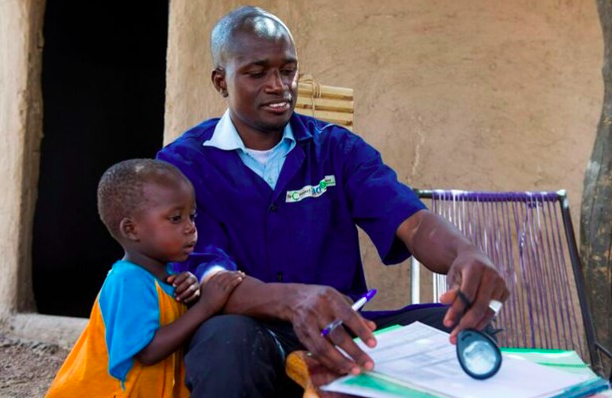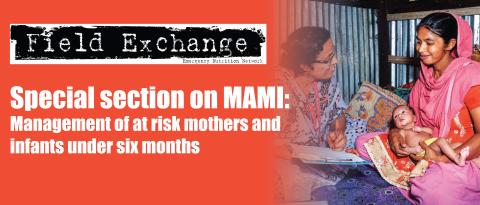A series of three related published papers share findings regarding quality of care, treatment outcomes and cost-effectiveness of uncomplicated SAM treatment delivered by community health workers (CHWs) in rural Mali.
By Eleanor Rogers, Karen Martínez, Jose Luis Alvarez Morán, Franck G. B. Alé, Pilar Charle, Saul Guerrero, Natalie Sessions and Chloe Puett
Quality of care for treatment of uncomplicated severe acute malnutrition delivered by community health workers in Mali
Research snapshot1
This paper presents findings of a cross-sectional study undertaken to assess the technical competence (quality of care) of community health workers (CHWs) managing cases of uncomplicated severe acute malnutrition (SAM) in a community-based management of acute malnutrition (CMAM) pilot programme in rural Mali. During this pilot scheme 18 CHWs were trained and equipped to treat uncomplicated cases of SAM in the community through eight days of initial training, on-the-job training and supervision, and a refresher course at six months. The capacity of these CHWs was assessed in terms of their capacity to:
a) evaluate, classify and treat cases of uncomplicated SAM;
b) provide nutritional counselling to caretakers of children receiving treatment for SAM, malaria, pneumonia or diarrhoea;
c) correctly refer cases of complicated SAM; and
d) demonstrate interpersonal skills in their interactions with caretakers and children.
The study was conducted by trained enumerators during November 2015. Five teams of two observers collected data over a two-week period, evaluating 17 CHWs in three communes in the region of Kita, southwest Mali. Observers were medical doctors or nurses with experience in malnutrition treatment protocols who had been trained on data collection over five days. Direct observations were made of the management of SAM by CHWs using checklists, rediagnosed cases admitted for treatment and reviewed admissions cards and registers. In total 125 SAM cases, assessed and treated by CHWs, were observed. Most children were correctly assessed for the presence of major clinical signs (cough, diarrhoea, fever and vomiting; 97.6%), and for the presence of danger signs (95.2%). Mid- upper arm circumference (MUAC) was correctly assessed in 96.8% of children and oedema was correctly assessed in 78.4%. The composite indicator, which includes all essential tasks to provide high- quality treatment for SAM, was achieved in 79.5% of cases; i.e. the child was appropriately assessed for key indicators, correctly classified and treated, and recieved key counselling.
The authors conclude that well- trained and supervised CHWs are capable of managing cases of uncomplicated SAM. This strategy provides an opportunity to increase access to quality treatment in Mali for SAM cases. Furhter evidence is required to ensure that this level of care can be achieved at scale, with a reduced level of supervision by non-governmental organisation (NGO) partners.
Effectiveness of treatment for severe acute malnutrition delivered by community health workers compared to a traditional facility-based model
Research snapshot2
A total of 699 children under five years of age were admitted to the intervention group and 235 children to the control group. Comparability of the two groups was ensured by identifying key indicators in a baseline survey carried out prior to the intervention and ‘matched pair’ analysis was used to mitigate the lower sample size in the control group. The intervention group reported cure ratios of 94.2% compared to 88.6% in the control group (risk ratio 1.07 [95% CI 1.01; 1.13]). Defaulter ratios were twice as high in the control group compared to the intervention group (10.8% vs 4.5%; RR 0.42 [95% CI 0.25; 0.71]). Differences in mortality ratios were not statistically significant (0.9% in the intervention group compared to 0.8% in the control group). Coverage rates in December 2015 were 86.7% in the intervention group compared to 41.6% in the control (p<0.0001).
Results suggest that CHWs can treat SAM in the community appropriately with minimal training. The authors conclude that allowing CHWs to treat SAM reduces defaulter ratios without compromising treatment outcomes and can improve access to treatment.

Cost-effectiveness of the treatment of uncomplicated severe acute malnutrition by community health workers compared to treatment provided at an outpatient facility in rural Mali
Research snapshot3
The Malian Nutrition Division of the Ministry of Health and Action Against Hunger tested the feasibility of integrating treatment of severe acute malnutrition (SAM) into the existing Integrated Community Case Management package delivered by community health workers (CHWs). The study assessed costs and cost-effectiveness of CHW-delivered care compared to outpatient facility-based care. Activity-based costing methods and a societal perspective were used to include all relevant costs incurred by institutions, beneficiaries and communities. The intervention and control arms enrolled different numbers of children, so a modelled scenario-sensitivity analysis was conducted to assess the cost-effectiveness of the two arms, assuming equal numbers of children enrolled.
In the base case, with unequal numbers of children in each arm, for CHW-delivered care the cost per child treated was 244 USD and cost per child recovered was 259 USD. Outpatient facility-based care was less cost-effective at 442 USD per child treated and 501 USD per child recovered. The conclusions of the analysis changed in the modelled scenario-sensitivity analysis, with outpatient facility-based care being marginally more cost-effective (cost per child treated was 188 USD, cost per child recovered was 214 USD), compared to CHW-delivered care. This suggests that achieving good coverage was a key factor influencing cost-effectiveness of CHWs delivering treatment for SAM in this setting. Per week of treatment, households receiving CHW-delivered care spent half of the time receiving treatment and three times less money (primarily due to reduced transport costs) compared with those receiving treatment from the outpatient facility.
This study supports existing evidence that the delivery of treatment by CHWs is a cost-effective intervention, provided that good coverage is achieved. Further research is needed on the costs to government of implementing this strategy.
Endnotes
1Alvarez Morán JL, Alé FGB, Rogers E, Guerrero S. Quality of care for treatment of uncomplicated severe acute malnutrition delivered by community health workers in a rural area of Mali. Matern Child Nutr. 2017; e12449. https://doi.org/10.1111/mcn.12449
2Alvarez Morán JL, Alé FGB, Charle P, Sessions N, Doumbia S, Guerrero S. The effectiveness of treatment for Severe Acute Malnutrition (SAM) delivered by community health workers compared to a traditional facility based model. BMC Health Services Research (2018) 18:207 https://doi.org/10.1186/s12913-018-2987-z
3Rogers E, Martínez E, Alvarez Morán JL, Franck Alé GB, Charle P, Guerrero S, and Puett C. Cost-effectiveness of the treatment of uncomplicated severe acute malnutrition by community health workers compared to treatment provided at an outpatient facility in rural Mali. Rogers et al. Human Resources for Health (2018) 16:12 https://doi.org/10.1186/s12960-018-0273-0


